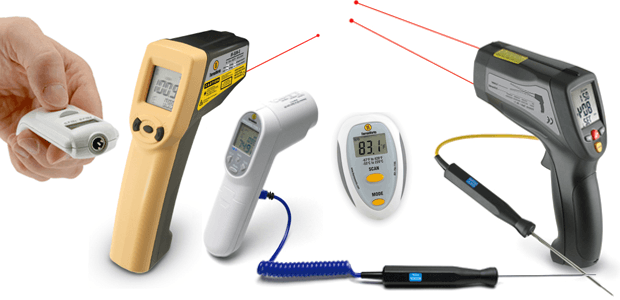An Introduction to Infrared Thermometry
From time to time, here on the ThermoWorks blog, we will turn our attention from the Thermapen toward other worthy topics in thermometry. One thing we get a lot of questions about is our line of infrared thermometer guns. Infrared thermometers provide the convenience of point-and-shoot technology which can be very useful for out-of-the-way locations where you need to get a reading and for quick measurements of surface temperatures in a skillet, kiln, and in many industrial settings. They can also be surprisingly affordable.
But there are some important concepts you need to understand to get the best use out of your infrared thermometer. Here is a brief introduction (over the next few weeks we’ll take a closer look at some of these ideas):
The first important stipulation is that all ThermoWorks thermometer products except for one are intended for food service, food processing, industrial, scientific and general home use. Our only FDA-cleared thermometer is the WAND™. It is an infrared forehead thermometer that uses an algorithm to translate forehead temperatures to oral-temperature equivalents. For more information on using infrared thermometers for health screenings, read this other article with important considerations.
Distance to Target Ratio
Listed on the thermometer, the Distance to Target Ratio (or “Distance to Spot Size”) tells you the diameter of the surface area an IR thermometer will measure at a given distance. For example, an IR thermometer with a 12:1 ratio will measure the temperature of a 1″ diameter of surface area from 12″ away, a 2″ diameter area from 24″ away and so on. If the thermometer as a 1:1 ratio or less, it should be held as close to the target as possible.
The area being measured will only be a circle if the IR thermometer is held perpendicular to surface, otherwise it will be elliptical. Check your unit’s specifications for “minimum spot size.”
Field of View
IR thermometer readings are averages of all temperatures within the target area being measured. An IR thermometer pointed directly at a porous grill grate will also “see” the heat source below the grate and average its temperature into the final reading—which may well be outside the thermometer’s specifications (resulting in a “HI” error).
In some products, one or two lasers are available to help indicate the area being measured. Sometimes these lasers indicate the center of the area being measured and sometimes the edge. They can also change position depending upon distance. Be sure to read product instructions about the placement of laser guides.
Calibration/Verification
You cannot verify the accuracy of an IR thermometer by comparing it to an immersion thermometer that is beneath the surface of a liquid or semi-solid in a non-controlled environment. Similarly, pointing an IR thermometer at human skin will yield a reading closer to 93°F (34°C) than 98.6°F (37°C).
Boiling water is NOT a preferred test method as the steam interferes with the surface reading and can also condense on the IR lens. Use a properly prepared ice bath and an emissivity setting of 0.95 or 0.97. Be sure to hold the IR thermometer directly above and perpendicular to surface of the water (usually about 3″ above it) to avoid measuring the sides of the container.
Emissivity Setting
Emissivity is a measure of a material’s ability to emit infrared energy. Some IR thermometers come with adjustable emissivity, so you can more accurately prepare the IR thermometer for the surface being measured. Some units have fixed emissivity settings of 0.95 or 0.97 to simplify operation while leaving them suitable for most material surfaces.
Most organic materials have an emissivity of 0.95. One way to test the temperature of a non-organic cooking metal with a fixed-emissivity IR thermometer is to coat the metal with vegetable oil, wait for the oil to come up to temperature and then test the surface of the oil. Other metals can be tested by spraying a spot with flat black paint or by applying a spot of black tape.
See some common emissivity values here, but be aware that these values are only approximate. The actual emissivity of a surface will vary depending upon its texture, color and temperature. ThermoWorks recommends comparing measurements found with an accurate surface probe or wire probe, in the first instance, and then adjusting the infrared thermometer’s emissivity to produce the same temperature value in the same location. The infrared thermometer can then be used for subsequent measurements with confidence.
A note on medical infrared thermometers
Forehead thermometers, like the WAND™ come with preset emissivity settings for human skin. The want uses an algorithm to interpret external forehead temperature as internal temperature. If using a forehead thermometer on other surfaces, be sure it is in the correct mode for accurate reading.


